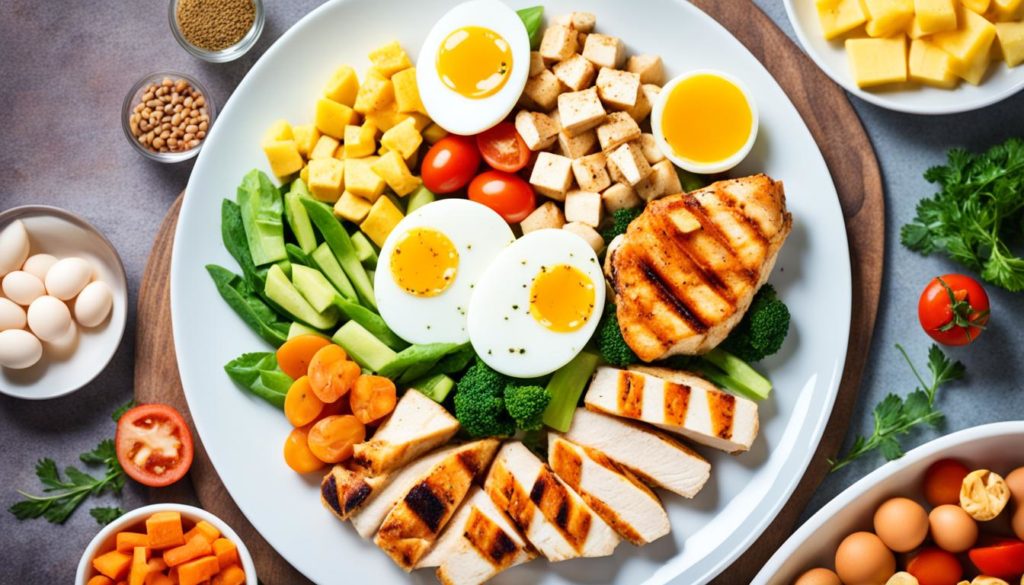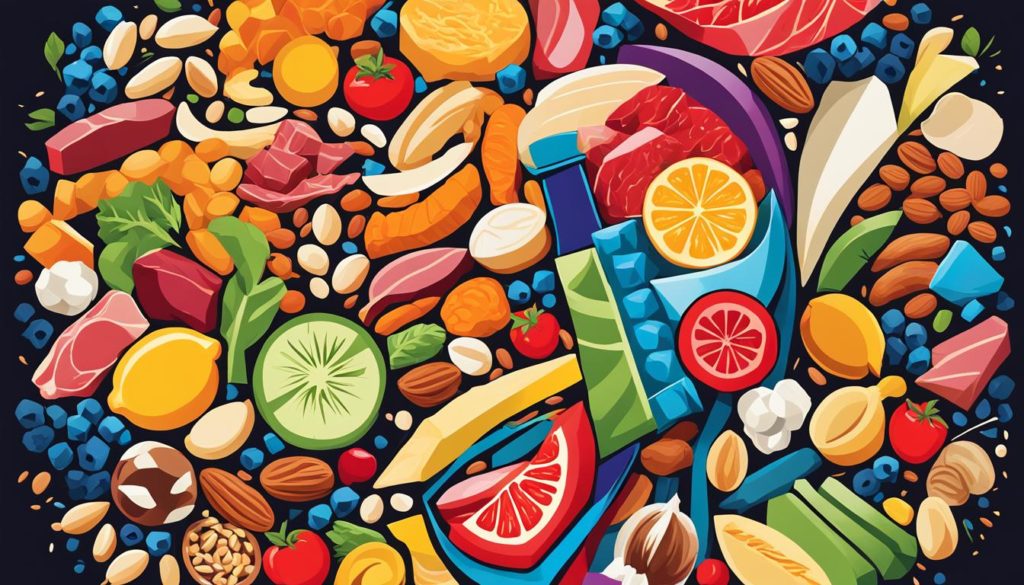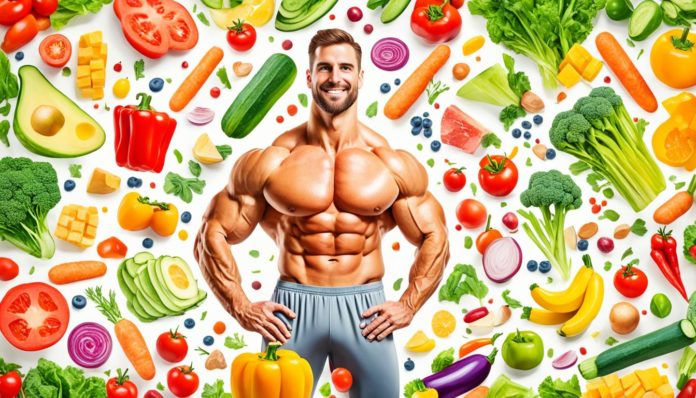Did you know people on high-protein low-carb diets can lose up to three times more weight than those on a standard calorie-restricted diet? This approach combines more protein and less carbs for effective weight loss.
This diet focuses on the benefits of high protein and a low-carb lifestyle. It’s not just for quick weight loss. It also boosts metabolic health by tailoring the diet to your needs. With benefits like faster fat loss and better metabolic health, it’s becoming more popular.
Key Takeaways
- High-protein low-carb diets promote effective weight loss, often tripling results compared to standard diets.
- The approach targets increased protein intake while reducing carbohydrates, enhancing metabolic benefits.
- Customization is key: the diet plan should be tailored to individual dietary needs and preferences.
- Benefits include accelerated fat loss and improved metabolic health.
- This dietary strategy is versatile and can be adapted to fit various lifestyles.
Understanding High-Protein Low-Carb Diets
High-protein low-carb diets are getting more popular for weight loss and better health. They focus on eating more protein and less carbs. This eating plan is based on science, looking at how our bodies react to different foods.

What is a High-Protein Low-Carb Diet?
This diet is all about eating more proteins from meats, dairy, and legumes. It cuts down on carbs like bread, pasta, and sweets. The aim is to eat fewer carbs to control blood sugar and eat less overall. It’s great for losing weight and keeping muscles strong.
How Does It Work?
When you eat fewer carbs, your body starts using fat for energy instead of sugar. This is called ketogenesis. Eating protein is key because it helps fix and grow muscles and keeps calories low. This diet is supported by science, showing how our bodies can switch to using fat better when we eat fewer carbs.
Benefits of High-Protein Diet
Eating a high-protein diet has many benefits for your health. It helps with weight loss, muscle growth, and boosts metabolism. These benefits are key to a healthy lifestyle.

Weight Loss
A high-protein diet helps you lose weight in several ways. It increases your body’s calorie burn, boosting your metabolism. Protein also makes you feel full, reducing how many calories you eat.
This makes it easier to follow a diet and lose weight.
Muscle Building
Protein is vital for building muscles. It gives your body the amino acids it needs to repair and grow muscles. This increases your muscle mass, making you stronger and more energetic.
Having more muscle mass is important for fitness and keeping a healthy weight.
Improved Metabolism
Eating more protein can improve your metabolism. Protein burns more calories during digestion than fats or carbs. This helps with weight loss and keeping weight off over time.
Crafting a Low-Carb Diet Plan
Starting a low-carb diet might seem hard, but it can be easy and effective with the right steps. This guide will help you set dietary goals, use meal prep strategies, and track your fitness for better nutrition.
Setting Realistic Goals
First, set realistic dietary goals. It’s important to have goals that fit your life and body’s needs. Start with small, easy goals and move forward slowly. Getting advice from a nutritionist can help make these goals right for you.
Meal Planning Tips
Good meal prep is key to following a low-carb diet. Start with a weekly meal plan that includes lots of protein and low-carb veggies. Batch cooking and controlling portions can save time and keep healthy food ready.
- Incorporate lean proteins like chicken, turkey, and fish.
- Include a variety of low-carb vegetables, such as spinach, broccoli, and bell peppers.
- Prepare healthy snacks like nuts and cheese to avoid high-carb temptations.
Tracking Your Progress
Keeping track of your progress is key to a successful low-carb diet. Use fitness tracking tools and apps to log your meals, workouts, and progress. This helps you tweak your diet and stay on course to meet your goals.
Here is a table to show how each strategy helps in a low-carb diet plan:
| Strategy | Benefit | Execution |
|---|---|---|
| Setting Realistic Goals | Achievable targets and sustained motivation | Consult a nutritionist, set small milestones |
| Meal Planning | Saves time, ensures healthy food choices | Create a weekly meal plan, batch cooking |
| Tracking Progress | Helps adjust diet, ensures goal alignment | Use fitness apps, log meals and exercises |
Weight Loss with High-Protein Low-Carb Diets
Starting a high-protein low-carb diet can lead to big changes. People share their stories of success and the hurdles they faced. They talk about how they kept going over time.
Success Stories
Many have found high-protein low-carb diets work well. Actress Halle Berry uses it to stay fit and control her diabetes. Athlete Tom Brady credits it for his top performance.
These stories show how important sticking to it is. They talk about quick wins and the need for long-term commitment for lasting weight loss.
Common Pitfalls to Avoid
High-protein low-carb diets can be great, but watch out for common mistakes. Many start strong but lose interest quickly. This leads to not sticking with it.
Not planning meals well is a big mistake. Without a plan, you might go back to eating too many carbs. Dehydration is also a problem that’s often ignored but is key to success. And, eating out can throw you off track, so you need strategies to stay on course.
| Common Pitfall | Solution |
|---|---|
| Meal Planning Failures | Adopt a structured meal plan |
| Dehydration | Increase water intake |
| Social Pressures | Prepare and carry healthy snacks |
Steer clear of these diet traps to make sure your high-protein low-carb diet stays strong and keeps giving results over time.
Top High-Protein Foods List
For those looking to lose weight and follow a healthy diet, knowing about protein sources is key. Both lean meats and plant-based proteins are great options. They help make any diet more balanced.
We’ve put together a list of the best protein sources. It includes lean meats, seafood, dairy, and plant-based proteins. This list will help you make smart food choices.
| Category | Food | Benefits |
|---|---|---|
| Lean Meats | Chicken breast, Turkey sticks, Ground turkey | High in protein, low in fat |
| Seafood | Salmon, Tuna, Shrimp | Rich in omega-3 fatty acids and protein |
| Dairy | Greek yogurt, Cottage cheese, Kefir | Excellent calcium source, supports gut health |
| Plant-Based Proteins | Tofu, Edamame, Hemp seeds, Pumpkin seeds | Nutrient-dense, offers essential amino acids |
Adding these protein sources to your diet can help you meet your protein needs. Whether from lean meats or plants, it’s good for you. Eating high-protein, low-carb foods can lead to weight loss and better health. It can also help control blood sugar and lower heart disease risks.
Exploring Keto Diet Benefits
The ketogenic lifestyle is getting a lot of attention for its benefits. It helps with weight loss and has a special way of working. By changing the body to use fat for energy, people can see many health benefits.
Ketosis and Weight Loss
When the body is in ketosis, it stops using glucose for energy and starts burning fat. This can lead to a lot of weight loss and better control over hunger. Many people find it easier to stick with the keto diet because they feel less hungry and more full.
Health Advantages
The keto diet is not just about losing weight. It has many health benefits. It can improve brain function, keep blood sugar stable, and reduce inflammation. For people with epilepsy, it’s a proven way to help manage seizures.
Comparing Keto and Other Diets
When you compare diets, the keto diet stands out. It’s different from other diets because it’s high in fat and low in carbs. This can be great for those looking for more energy, clear thinking, and better metabolic health.
Best High-Protein Low-Carb Recipes
Explore these exciting meal ideas perfect for a high-protein, low-carb lifestyle. From energizing breakfasts to filling lunches and hearty dinners, there’s something for everyone. These options will keep you satisfied and on track with your diet.
Breakfast Recipes
Starting your day with a protein-rich breakfast gives you energy and vitality. Check out these tasty options:
- Greek Yogurt with Berries and Nuts – Combine Greek yogurt with fresh berries and a handful of nuts for a quick and nutritious start.
- Spinach and Feta Omelet – Whip up an omelet with spinach, feta cheese, and a sprinkle of herbs for a protein-packed morning meal.
- Scrambled Eggs with Smoked Salmon – Mix scrambled eggs with smoked salmon and avocado slices for a gourmet breakfast experience.
Lunch Options
These low-carb lunches are both satisfying and delicious. They’re perfect for keeping your energy levels stable all day:
- Chicken Caesar Salad – Enjoy a classic salad with grilled chicken, romaine lettuce, parmesan cheese, and a low-carb dressing.
- Tuna Avocado Boats – Halve an avocado and fill each side with a mix of tuna, mayo, and a dash of lemon juice for a creamy and filling meal.
- Turkey Lettuce Wraps – Use large lettuce leaves to wrap turkey slices, cheese, and fresh veggies for a light yet satisfying lunch.
Dinner Ideas
High-protein dinners are key for muscle maintenance and recovery at night. Here are some great options:
- Grilled Salmon with Asparagus – Grill a salmon fillet and serve it alongside roasted asparagus seasoned with lemon and garlic.
- Beef Stir-Fry with Broccoli – Stir-fry lean beef strips with broccoli, bell peppers, and soy sauce for a quick and flavorful meal.
- Baked Chicken Breasts – Marinate chicken breasts in herbs and olive oil, then bake until tender. Serve with a side of sautéed spinach.
Low-Carb Diet for Muscle Building
Building muscle on a low-carb diet can be tough, but it’s doable and effective. Focus on key nutrients and a structured exercise plan, especially strength training. This approach helps you grow muscles without needing lots of carbs. It’s all about finding the right balance for muscle repair and energy.
Key Nutrients for Muscle Growth
For muscle building, eat lots of lean meats, fish, and eggs. These are packed with amino acids your muscles need to repair. Also, add foods rich in healthy fats like avocados and nuts to make up for the low carbs. Getting enough of these nutrients is key for muscle recovery and growth.
Exercise Recommendations
Strength training and resistance exercises are key for muscle growth. Workouts like squats, deadlifts, and bench presses target big muscle groups. These exercises make your muscles work hard, helping you grow. Make sure to balance intense workouts with rest days to avoid overdoing it.
Balancing Diet and Exercise
It’s important to balance your diet and exercise for muscle building. Eat foods full of nutrients to fuel your workouts and help muscles repair. Drinking plenty of water and eating at the right times can also boost your results. With a good diet and consistent exercise, you can meet your muscle building goals.
For more tips on using a low-carb diet for muscle building, check out this Healthline article.
FAQ
What is a High-Protein Low-Carb Diet?
This diet focuses on eating more protein and less carbs. It helps your body burn fat for energy, leading to weight loss.
How Does a High-Protein Low-Carb Diet Work?
By eating fewer carbs, your body starts to burn fat for energy. At the same time, more protein helps repair and grow muscles, boosting your metabolism.
What Are the Benefits of a High-Protein Diet?
High-protein diets help with weight loss, muscle building, and better metabolism. They make you burn more calories and keep you feeling full, aiding in weight management.
How Can I Set Realistic Goals for a Low-Carb Diet Plan?
Start by looking at what you currently eat and your health. Set goals you can reach, slowly cut carbs and eat more protein. A nutritionist can give you tailored advice.
What Are Some Effective Meal Planning Tips for a Low-Carb Diet?
Plan your meals ahead to stick to a low-carb diet. Include lots of protein-rich foods and veggies in your meals. Prepare meals in advance and keep them ready for easy access.
How Do I Track My Progress on a Low-Carb Diet?
Use apps to track your carbs, proteins, and calories. Weigh and measure yourself regularly. Keeping a food diary helps spot areas to improve.
Are There Real Success Stories of Weight Loss with High-Protein Low-Carb Diets?
Yes, many people have lost weight on these diets. Their stories show the power of being consistent, setting realistic goals, and having a diet tailored to your needs.
What Are Common Pitfalls to Avoid in High-Protein Low-Carb Diets?
Avoid not planning meals, not getting enough fiber, and not drinking enough water. Stay away from processed foods and make sure you get all the nutrients you need to stay healthy.
What Are the Top High-Protein Foods I Should Include in My Diet?
Eat lean meats, seafood, dairy, and plant-based proteins like beans. These foods are packed with nutrients and help with weight loss and muscle building.
What Are the Benefits of a Keto Diet?
The keto diet promotes weight loss by putting your body into ketosis. It also improves insulin sensitivity, blood sugar control, and reduces inflammation.
How Do Keto Diets Compare with Other Diets?
Keto diets are unique in inducing ketosis, which helps burn fat even when you’re not active. They can lead to faster weight loss and metabolic benefits but require strict carb limits.
What Are Some Best High-Protein Low-Carb Recipes?
Try scrambled eggs with spinach for breakfast, grilled chicken salad for lunch, and baked salmon with veggies for dinner. These meals are tasty, nutritious, and keep carbs low.
How Can a Low-Carb Diet Aid in Muscle Building?
A low-carb diet helps build muscle by providing the right nutrients like proteins and healthy fats. Pairing it with strength training can help you gain muscle while keeping body fat in check.
What Nutrients Are Essential for Muscle Growth on a Low-Carb Diet?
You need high-quality proteins, healthy fats, and vitamins and minerals. Include lean meats, fish, eggs, nuts, and green veggies in your diet to support muscle repair and growth.
What Exercise Recommendations Are Suitable for High-Protein Low-Carb Diets?
Strength training like weight lifting, resistance band workouts, and body-weight exercises are best. These exercises help build muscle and strength, which complements the diet’s muscle-building effects.
How Do I Balance Diet and Exercise for Optimal Results?
Balance your diet with the right nutrients for your workouts and recovery. Mix strength training with aerobic exercises, and adjust your diet based on your activity level for the best results.


